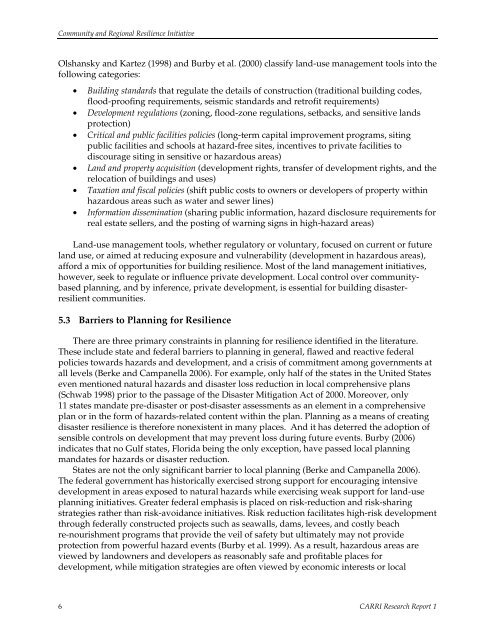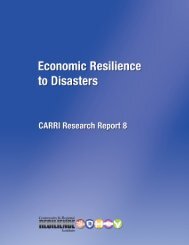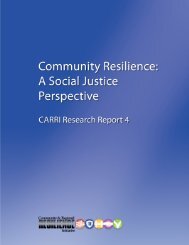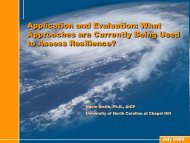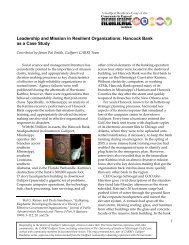Community and Regional Resilience - Community & Regional ...
Community and Regional Resilience - Community & Regional ...
Community and Regional Resilience - Community & Regional ...
Create successful ePaper yourself
Turn your PDF publications into a flip-book with our unique Google optimized e-Paper software.
<strong>Community</strong> <strong>and</strong> <strong>Regional</strong> <strong>Resilience</strong> InitiativeOlshansky <strong>and</strong> Kartez (1998) <strong>and</strong> Burby et al. (2000) classify l<strong>and</strong>-use management tools into thefollowing categories:• Building st<strong>and</strong>ards that regulate the details of construction (traditional building codes,flood-proofing requirements, seismic st<strong>and</strong>ards <strong>and</strong> retrofit requirements)• Development regulations (zoning, flood-zone regulations, setbacks, <strong>and</strong> sensitive l<strong>and</strong>sprotection)• Critical <strong>and</strong> public facilities policies (long-term capital improvement programs, sitingpublic facilities <strong>and</strong> schools at hazard-free sites, incentives to private facilities todiscourage siting in sensitive or hazardous areas)• L<strong>and</strong> <strong>and</strong> property acquisition (development rights, transfer of development rights, <strong>and</strong> therelocation of buildings <strong>and</strong> uses)• Taxation <strong>and</strong> fiscal policies (shift public costs to owners or developers of property withinhazardous areas such as water <strong>and</strong> sewer lines)• Information dissemination (sharing public information, hazard disclosure requirements forreal estate sellers, <strong>and</strong> the posting of warning signs in high-hazard areas)L<strong>and</strong>-use management tools, whether regulatory or voluntary, focused on current or futurel<strong>and</strong> use, or aimed at reducing exposure <strong>and</strong> vulnerability (development in hazardous areas),afford a mix of opportunities for building resilience. Most of the l<strong>and</strong> management initiatives,however, seek to regulate or influence private development. Local control over communitybasedplanning, <strong>and</strong> by inference, private development, is essential for building disasterresilientcommunities.5.3 Barriers to Planning for <strong>Resilience</strong>There are three primary constraints in planning for resilience identified in the literature.These include state <strong>and</strong> federal barriers to planning in general, flawed <strong>and</strong> reactive federalpolicies towards hazards <strong>and</strong> development, <strong>and</strong> a crisis of commitment among governments atall levels (Berke <strong>and</strong> Campanella 2006). For example, only half of the states in the United Stateseven mentioned natural hazards <strong>and</strong> disaster loss reduction in local comprehensive plans(Schwab 1998) prior to the passage of the Disaster Mitigation Act of 2000. Moreover, only11 states m<strong>and</strong>ate pre-disaster or post-disaster assessments as an element in a comprehensiveplan or in the form of hazards-related content within the plan. Planning as a means of creatingdisaster resilience is therefore nonexistent in many places. And it has deterred the adoption ofsensible controls on development that may prevent loss during future events. Burby (2006)indicates that no Gulf states, Florida being the only exception, have passed local planningm<strong>and</strong>ates for hazards or disaster reduction.States are not the only significant barrier to local planning (Berke <strong>and</strong> Campanella 2006).The federal government has historically exercised strong support for encouraging intensivedevelopment in areas exposed to natural hazards while exercising weak support for l<strong>and</strong>-useplanning initiatives. Greater federal emphasis is placed on risk-reduction <strong>and</strong> risk-sharingstrategies rather than risk-avoidance initiatives. Risk reduction facilitates high-risk developmentthrough federally constructed projects such as seawalls, dams, levees, <strong>and</strong> costly beachre-nourishment programs that provide the veil of safety but ultimately may not provideprotection from powerful hazard events (Burby et al. 1999). As a result, hazardous areas areviewed by l<strong>and</strong>owners <strong>and</strong> developers as reasonably safe <strong>and</strong> profitable places fordevelopment, while mitigation strategies are often viewed by economic interests or local6 CARRI Research Report 1


